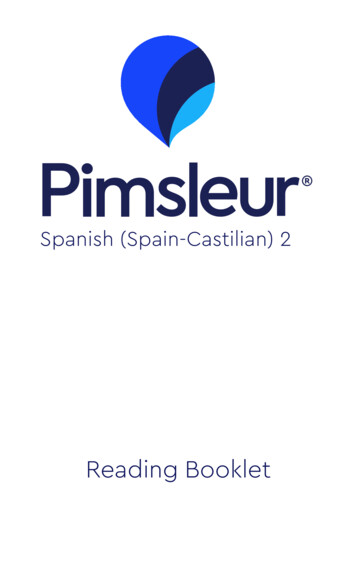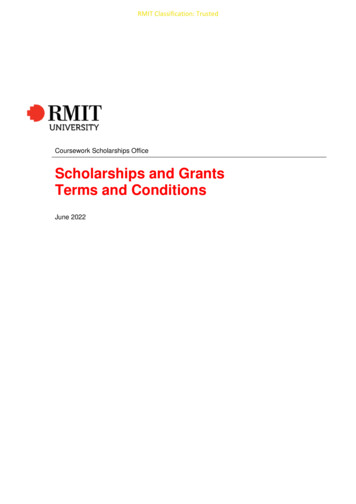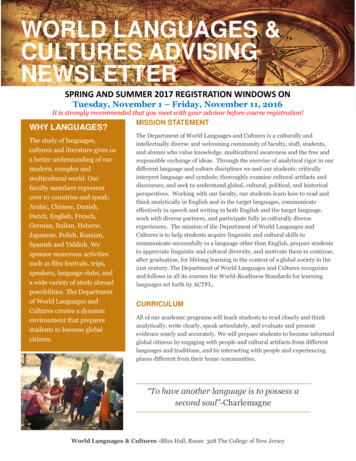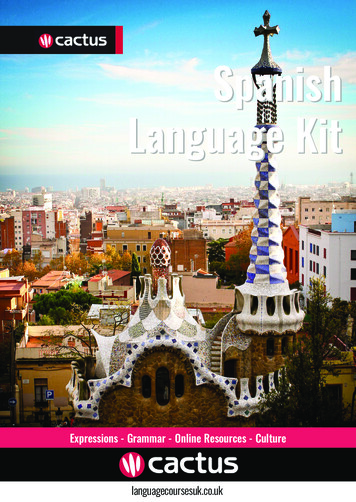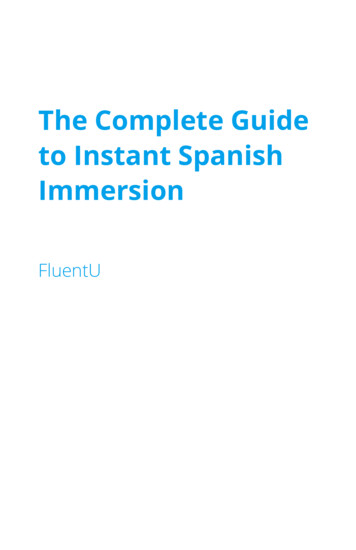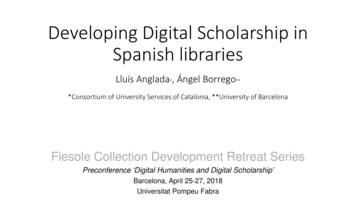
Transcription
Developing Digital Scholarship inSpanish librariesLluís Anglada*, Ángel Borrego***Consortium of University Services of Catalonia, **University of BarcelonaFiesole Collection Development Retreat SeriesPreconference ‘Digital Humanities and Digital Scholarship’Barcelona, April 25-27, 2018Universitat Pompeu Fabra
Summary1. Spanish academic libraries in context1. Evolution2. Research support services in REBIUN strategic plans2. Services for researchers, today
Spanish UniversitiesDatos y cifras del sistema universitario español. Curso 2015/2016 84 universities in 343 campus Spanish public universities tend to be disperse. An average of 4-5 campus per university is normal,with large universities having more than 15 campus. 34 universities are private (private universities are in expansion) Students (global) 1.500.000 (average) 19.000 students / university 31,5% of people between 18-24 are attending to universities. What do Spanish universities have in common? All universities do teach and researchHowever, the majority of the private universities are only teaching oriented Professors are evaluated, but universities are not Research is basically developed in: University departments or institutes CSIC institutes and some Spanish large research centers Autonomous research institutes (more common in Catalonia)
Big changes in few years“Pasado, presente y futuro de las bibliotecas universitarias españolas”The situation in 1984The big change: 1985-1995 Universities centrally controlled by thegovernment Library system 1983 new law for universities (LRU)gave autonomy to universities Library system Main library library with old and rarebooks Some faculty libraries and a lot ofdepartment libraries No coordination at all Resources Very poor budgets (and very decentralized) No professional staff Services were at the library level (not at theuniversity level) All the university libraries The Library ofthe University New (and young) library directors Creation of technical services andorganization chart Resources Central budgetsLibrary automationFirst new buildingsServices modernization
From libraries to CRAI“From the library to the Information Commons" CRAI Resource centers for learning and research Influenced by the UK's movement (Follet report, and convergence of services)Tthe library as a service point (for books, computers, information.)New libraries are built under this conceptionLibraries focused on users Library buildings New (almost all) or renovated (the rest)ModernBig (6-8.000 m2)Campus librariesEvolution of square meters in Spanishacademic library buildings 1988 - 229.093 1995 - 456.031 2000 - 736.572 2004 - 974.319 2007 - 1.009.978
Polytechnic University of Catalonia (UPC). Rector G. Ferraté Library
Pompeu Fabra University- Ciutadella campus- Poblenou campus- Mar campus
University of Girona. Barri vell library
Girona University. Montilibi library
Lleida University, Biblioteca de Cappont
Rebiun (Association of Spanish Academic Libraries) strategic plans 2003-2006 Research is present in 1/13 actions 8% Actions research related: OA 2007-2011 Research is present in 3/26 actions 12% Actions research related: IR & OA 2012-2020 Research is present in 6/28 actions 21% Actions research related: IR & OA
IR & OA in Spanish academic libraries Spanish Science and Technology law Art. 35. (“Open-Access Publication”) mandate the creation and development of repositories and open-accessdissemination of publicly-funded research outcomes Repositories Almost all universities have their own IR (53 IR)340 FTE staff1.228.345 documents, but (only) 282.385 (23%) are journal articles and 79.665 (6,49%) are OADSpace (89%) is clearly the most predominant technology platform Recolecta, created together by REBIUN and FECYT in 2008, is an aggregator of the IR for theSpanish scientific publications. http://www.recolecta.net Spanish OA journals aggregators REDIB https://www.redib.org/ Dialnet https://dialnet.unirioja.es/ RACO http://www.raco.cat/index.php/raco
The key issue: The relations between Spanish academic libraries and researchers havealways been weak Spanish libraries are rich in heritage collections and academic libraries have been heritageoriented during a long period Traditionally, professors have done the selection of new acquisitions– Libraries had a passive role building collections We don't have the figures of the reference or the subject librarian– Recently, some libraries introduced the figure of the liaison librarian, a link between universitydepartments (research) and libraries.– The students advisor function is not rooted in the library University teaching methods are mostly based on exams (and not in essays)– The ratio between borrowed documents and student is lower than in other university systems Licensing has been done by consortia at regional level– In the last years, consortia act together to negotiate licenses with big publishers
Evolution of Catalan university libraries activities and organization supporting research Traditional activities supporting research:– Collection buildings Acquisitions, Journals collections, Special collections – The big change of the networked digital information The content is on your PC, tablet, mobile New tools and rules are completely strange to the majority of researchers– Identifiers, OA, mandates, altmetrics Open Science as the new landscape Our evolution supporting research– Since 2005 (approx.), Catalan university libraries made changes in their services and organization to adapt to thenew situation subject librarians, reference management tools, open access – In 2013, CBUC had also changed and created a new strategic line for supporting research repositories, Mendeley, portal for Catalan research, OA – but Internet is disruptive, and in 2017 (Feb) we decided to be more radical and create a new (small) areadevoted to 'Open Science’ open metadata (portal for Catalan research), open access, open data
Summary1. Spanish academic libraries in context1. Evolution2. Research support services in REBIUN strategic plans2. Services for researchers, today
Methodology Online survey to the 76 directors of the Spanish association ofacademic libraries (January – February 2018). 57 replies (75%).
Size of Spanish academic libraries (staff FTE)Average: 87 peopleMedian: 78 people
The library in the structure of the University
Research support services
Size of research support services (staff FTE)Average: 6.4 peopleMedian: 3.0 people
Library size vs research support services size
Relationships with other servicesTechnology Transfer Offices (OTRI)[European] research projects managementGraduate / Doctoral schoolsPublicationsBibliometric units
Ranking of research support servicesRespondents ranked 6 services in order of preference from 1 (most important) to 6 (least important)
Users of research support services
Many thanksQuestions? langlada@gmail.com borrego@ub.edu http://www.ub.edu/blokdebid/
Library system Main library library with old and rare books Some faculty libraries and a lot of department libraries No coordination at all Resources Very poor budgets (and very decentralized) No professional staff Services were at the library level (not at the university level) The big change: 1985-1995

